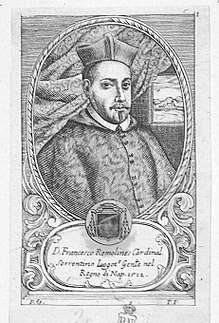Francisco de Remolins
Francisco de Remolins (1462–1518) (called the Cardinal of Sorrento and il cardinale Elvense) was a Spanish Roman Catholic bishop and cardinal.

Biography
Francisco de Remolins was born in Lleida in 1462.[1] He studied law at the University of Lleida, and then at the University of Pisa, from which he received a doctorate of both laws.[1]
Remolins married as a young man, but his marriage was annulled and the young woman entered a convent.[1] Remolins received the tonsure and then became a secretary to Ferdinand II of Aragon.[1] The king later appointed him as his ambassador to the Holy See.[1] He then became a preceptor to Cesare Borgia.[1]
Remolins became cantor of the cathedral chapter of Mazzara.[1] He then became a protonotary apostolic.[1] He was later an auditor of the Roman Rota and an auditor of the governor of Rome.[1]
In 1496 Cardinal Luis Julian de Milà, Bishop of Lleida, named him auxiliary bishop of Lleida.[1] He was consecrated as a bishop by Cardinal de Milà ca. 1496.[1]
In 1498 he was sent to Florence along with Gioacchino Torriani, Master of the Order of Preachers, as Commissary Apostolic to initiate process against Girolamo Savonarola; Savonarola was sentenced to death on 18 May 1498.[1]
Because of his family's closeness to Pope Alexander VI, he then resigned as auxiliary bishop of Lleida to join the papal court.[1] In February 1501, the pope appointed him governor of Rome; as governor, he carried on a bloody repression of the pope's enemies, the Colonna family and the Orsini family.[1]
He was named Archbishop of Sorrento on 3 March 1501; he held this office until 23 January 1512.[1] He was taken prisoner by the Ottoman Empire and had to be ransomed by the church.[1]
Pope Alexander VI made him a cardinal priest in the consistory of 31 May 1503.[1] He received the titular church of Santi Giovanni e Paolo on 12 June 1503.[1]
He served as apostolic administrator of the see of Perugia from 4 August 1503 until March 1506.[1]
He participated in both the papal conclave of September 1503 that elected Pope Pius III and the papal conclave of October 1503 that elected Pope Julius II.[1]
Following the election of Pope Julius II, Cardinal Remolins feared reprisals against the House of Borgia and therefore escaped from Rome on 20 December 1503.[1] The pope, however, wrote him a conciliatory letter and the cardinal returned to Rome and entered the pope's service.[1]
As a diplomat, he secured the devolution of the Romagna from the Republic of Venice.[1] Also, in the course of the Italian War of 1499–1504, he acted in the service of Ferdinand II of Aragon against Louis XII of France.[1]
In 1504, he became Bishop of Fermo, occupying this see until his death, though without ever visiting the diocese in person.[1] In 1511, he replaced Ramón de Cardona as Viceroy of Naples, holding this office until 1513.[1]
He opted for the titular church of San Marcello al Corso on 27 October 1511, though also retaining the titulus of Santi Giovanni e Paolo in commendam until 6 July 1517.[1] At the end of 1511, he became archpriest of the Basilica di Santa Maria Maggiore. He attended the Fifth Council of the Lateran (1512–17).[1] On 23 January 1512 he became the apostolic administrator of the see of Palermo; he held this post until his death.[1] He played a part in establishing the Roman Inquisition in Palermo; he was a great supporter of the Inquisition.[1]
He participated in the papal conclave of 1513 that elected Pope Leo X.[1]
He was administrator of the see of Sarno from 22 June 1513 until 11 February 1517.[1]
In mid-1513, he was opposed to Pope Leo X giving clemency to Cardinals Bernardino López de Carvajal and Federico di Sanseverino.[1]
From 9 September 1513 until his death, he was administrator of the see of Gallipoli.[1] For the second half of 1515, he was also administrator of the see of Lavello.[1]
He opted for the order of cardinal bishops on 16 March 1517, taking the Suburbicarian Diocese of Albano.[1]
In May 1517, he was one of three cardinals who managed the process of two cardinals, Bandinello Sauli and Alfonso Petrucci, accused of plotting against the pope.[1] As president of this tribunal, he sentenced Cardinal Petrucci to death on 16 July 1517.[1] On 4 November 1517 he was one of eight cardinals appointed to a commission to wage war against the Ottoman Empire.[1]
He was the cardinal protector of the Servite Order.[1]
He died in Rome on 5 February 1518.[1] He was buried in the Basilica di Santa Maria Maggiore - he was allegedly buried alive because when his coffin was later opened, his arm was above his head.[1] He was reburied in Santa Maria sopra Minerva.[1]